GDP Prediction and Forecasting using Machine Learning
Tanvi Gharte1 , Himani Patil , Soniya Gawade- The topic of GDP has become of high importance among the indicators of economic variables. GDP predictionis a crucial job in the economy and growth analysis of a country. The goal of the paper is to give a different approach concerning the classical econometric techniques, and to show how Machine Learning techniques may improve calculating the Gross Domestic Product accurately. TheGDPofcountriesis impacted by various social, economic, and cultural parameters. We have analysed thoseparametersfrom1970 to 2018 and used supervised learning methods to build our models. Finally compared the performance of the model using 3 algorithms and therefore the best prediction performanceis achieved by Gradient Boosting, then Random Forest and Linear Regression. And finally, the model is deployed into a web application which estimates and forecasts GDP of a country just by giving some attribute as input forthat country.
Key Words: Gross Domestic Product, Machine Learning, Linear Regression, Random Forest, Gradient Boosting
1. INTRODUCTION
GDP is an important parameter to know the health and condition of a country compared to other countries. Therefore,knowingbeforehandaboutGDPhelpsinknowing whetheracountryisprogressingoritseconomichealthis declining. Gross domestic product is a measure to assess overall economic performance of a country, it includes all products and services created by the economy as well as personalconsumption,governmentpurchase,etc.
Theeconomicgrowthofthe countrydependsondifferent factorslikeSocial,EconomicandCulturalEnvironment.In oursystem,wehaveconsideredparameterslikepopulation, area,populationdensity,coastline,net migration,literacy, phones, infant mortality, arable land, crop land and other land,birthrate,deathrate,regionandclimatetocalculate the GDP per capita of the country. We have thus built a prediction model by including all such factors as independentvariableandworldGDPasdependentvariable.
Our aim is to predict and forecast GDP per capita for a countryusinglinearregression,randomforestandgradient boosting machine learning algorithms. Prediction of GDP involves application of applied mathematics and mathematicalmodelstopredictfuturedevelopmentswithin the economy. It permits us to review previous economic movementsandpredicthowevercurrenteconomicchanges can modify the patterns of previous trends. Hence, more
accuratepredictionwouldprovideasignificantfacilitationto thegovernmentinsettingupeconomicdevelopmentgoals. Consequently,acorrectGrossDomesticProductprediction presents a number one insight that associates an understandingforfutureeconomictrends.
2. LITERATURE SURVEY
GDPnotonlyhelpsindiagnosingtheeconomicproblembut alsohelpsincorrectingtheproblem.Keepingallthesepoints inconsideration,wehavechosenatopicofpredictingGDP whichcanbeusedbyanynormalcitizenwhoiswilling to knowtheGDPoftheircountry.ShelleyG.L.andWallaceF.H (2004)[1]studiedtherelationbetweenM1money,realGDP and inflation in Mexico for the period 1944 to 1991. Co integrationrelationshipsexistedbetweentheinflationand money hence study suggested that reduction in money growthmayhavebeenresultedinreductionofinflationin Mexico. The variations in inflation were divided into two components namely predictable and unpredictable components.Indifferencedinflation,predictableincreases resulted in having a negative effect on GDP growth. Unpredictableincreasesresultedinhavingapositiveeffect onrealGDPgrowth.Thispaperconsideredonlymoneyasan economicalfactorandneglectedotherimportantindicators ofeconomichealth.
Thepapertitled“GDPPredictionbySupportVectorMachine TrainedwithGeneticAlgorithm”waspublishedin2010by Gang Long [2]. In this study, a support vector machine trained with a genetic algorithm is applied in GDP forecasting.Authorconcludedthatthegeneticalgorithmcan getoptimalsolutionsinashorttime,whichisanexcellent methodinparametersselectionofsupportvectormachine. Then, a genetic algorithm is introduced to simultaneously optimizetheSVMparameters.TheGDPdatafrom1989to 2002usedfortrainingand2003to2007fortesting.Butthe limitation of this project is that other Machine Learning algorithmscanachievebetterperformancethanSVM.
Another paper titled “Predicting Gross Domestic Product UsingAutoregressiveModels”publishedin2017byJ.Roush, K. Siopes and G. Hu [3]. They used autoregressive models and then constructed a vector autoregressive model to predict GDP. The predicted result matches historical GDP data and predicts consistent future growth. Restriction of thisapproachisthatitfailstoovercomehistoriceconomic recession. This paper also didn’t account for the other parameterssuchastrade,economic,geographicaltopredict theGDPgrowth.

MartinSchneider,MartinSpitzer[4]developedaframework forshort termforecastingofrealGDPforAustriausingthe generalizeddynamicfactormodel.
VaishnaviPadmawar,PradnyaPawarandAkshitKarande[5] predictedGDP,usinglinearregressionandrandomforest. “RandomForest”utilizedduringthisstudyworkedwelland got86%accuracy.Butthismodelcanbeimprovedbyusing better machine learning algorithms to acquire more accuracy.

In the literature discussed above, none of the work consideredtheholisticviewofGDPdependenceonSocial, Economic,Geographical,Environmentalimpactstopredict world GDP. Most of the work focused on building mathematical or time series models. Therefore, in our proposed model we are trying to include all such comprehensiveparameters.Wewilllookatwhatparameters impacttheGDP,whatparametersarecorrelated.
3. METHODOLOGY
3.1 Design and Framework
In our proposed system, the objective is to build a GDP EstimationToolwithahigheraccuracyMLmodelthanthe existingone.Andoursystemcanbeusedgloballybyanyone and is not restricted to any certain group of users. Fig.1 showsthemachinelearningapproachoftheimplementation oftheproject.
A. DataCollection:
We will beusing Kagglefor gettingdata to predictfactors influencingthegrowthofGDP.Thedatasetconsistsof227 countrieswith20differentparameters.Theparametersthat aretakeninconsiderationwhilepredictingGDPareLiteracy, Net migration, Population, Infant mortality, Agricultural economy,Industrialeconomy,Serviceseconomy,etc.
B. DataPre processingandCleaning:
Data pre processing is required for cleaning the data and makingitsuitableforamachinelearningmodel.Ithelpsto increasetheaccuracyandefficiencyofamodel.Identifying andremovingerrorsandduplicatedata,inordertocreatea reliabledatasetisthemainaimofdatacleaning.Ourdataset consistsofsomemissingdatapoints,butitisnotextensive. 14/20 of our columns have missing data points. We have imputedsomemissingvaluesfrompastobservations.After data cleaning, there are no more missing values in the dataset.
Fig 2:Datasetafterpre processing
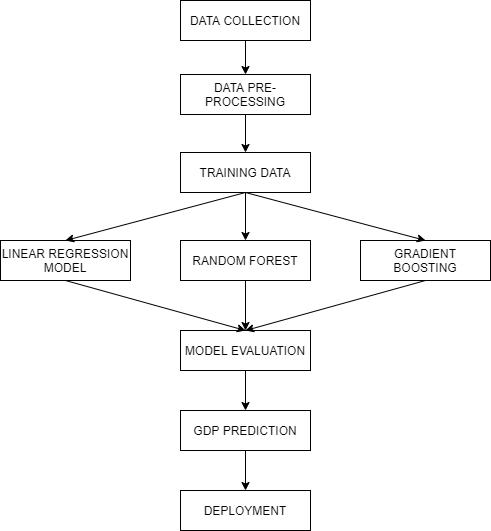
AboveFig.2showsthedatasetafterthedatapre processing.
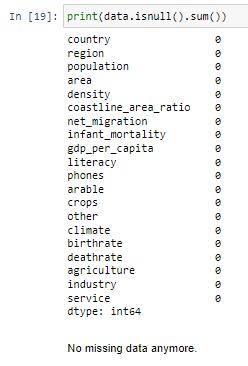
ExploratoryDataAnalysis(EDA)
We have performed EDA that uses a range of methods to gainadeeperunderstandingofadatasetandhelpstofind outliers.Wehaveplottedthecorrelationheatmapwhichis usedtovisualizecorrelationbetweendifferentfeaturesofa dataset.GivenFig.3presentsthematrixforthecorrelation between the dependent variable and the independent variables. We can see that there exist expected and unexpectedcorrelationsbetweentheparameterslikestrong correlationbetweeninfantmortalityandbirthrate,strong correlation between GDP per capita and phones and unexpected strong correlation between birthrate and phones,etc.
:ExploratoryDataAnalysis(EDA)
C. ModelTraining:
Thedifferentalgorithmsareusedtotrainandtestthesplit data. We have applied Linear Regression, Random Forest andGradientBoostingalgorithms.
D. ModelEvaluation:
After completion of model training, we have checked the accuracy of all the three machinelearning algorithms and consideredonewiththehighestaccuracy.Performanceof thesealgorithmsisevaluatedusingr2score.
E. GDPPredictionandDeployment:
Oncemodelevaluationisdone,wewillbeabletopredictthe GDP per capita for any country. And finally, the model is deployed into a web application which will estimate and forecastGDPofa country justby givingsomeattribute as inputforthatcountry.
3.2 Modelling
A. Linear Regression

Itisasupervisedmachinelearningalgorithmthatperforms aregressiontask.Basically,itisthemathematicalmodelthat analyses the linear relationship between a dependent variable with a given set of independent variables. In the projectwewillusesimplelinearregressiontopredictthe individual attribute of the dataset. For this 80% of the dataset was the training dataset i.e., used for training the modelandtheremaining20%wasusedtotestthedataset.
B. Random Forest
Itisoneofthewell knownmachinelearningalgorithmsthat belongs to the supervised learning technique category. Random Forest can be used both for regression and classificationproblemsinmachinelearning.Itisbasicallya classifierthatconsistsofdecisiontreesofthegivendataset on numerous subsets. Further, the algorithm takes the average in order to improve the forecasting accuracy. Predictions from each tree that is formed are taken into considerationinsteadofjustrelyingonasingledecisiontree andafterthat;basedonmajorityvotesofprediction,output ispredicted.
Thenwehavefirsttriedrandomforestwithourdatasplits (Withandwithoutfeatureselection).Scalingisnotgoingto betestedforRandomForest,sinceitshouldnotaffectthis algorithm’sperformance.Wehaveusedgridsearchinorder toobtaingoodparametersforourRFregressor.Andthenwe optimized the parameters like n estimators, min samples leaf,maxfeatures,bootstrap.
C. Gradient Boosting
Itisakindofmachinelearningalgorithmthatcanbeusedto solve classification or regression predictive modelling problems. The gradient boosting model starts by creating one leafand building regressiontrees.Basedon the error made by the previous tree, the gradient boosting model trains another tree, and it continues to make additional trees. It will work on previous errors and boost the performance.GradientBoostingisamethodwhichallowsus tocombinealltheweakmodels.Andafterthecombination ofvariousweakmodels,wegetasinglemodel,whichwill improvetheaccuracyofourmodel.Inthisproject,wewill first train the GBM regressor with the default parameter values, then we will try optimizing its parameters. The parameters we have optimized are Learning rate, n Estimator, Min sample leaf, max depth, Min sample split, subsample,maxfeatures.
4. RESULT AND ANALYSIS
True GDP per capita was plotted against the prediction in ordertoevaluatethemodelusinglinearregression.
Fig.4showsthedepictionoflinearregressionmodelfortrue GDPpercapitaprediction.TrueGDPpercapitawasplotted againstthepredictioninordertoevaluatethemodelusing linearregression.

Fig 4:LinearRegressionPredictionPerformance
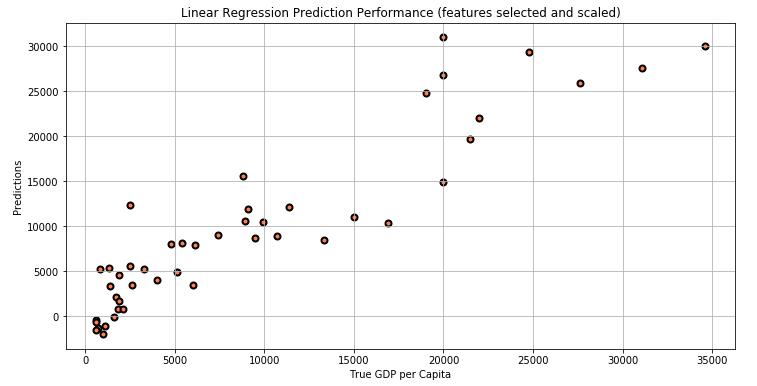
Table 1: LinearRegressionAccuracyPerformance
DataSplitting Criteria
MAE RMSE R2SCORE
Allfeatures, Noscaling 330350.858 1570337.545 29843.12
Allfeatures, withscaling 569019.468 1283170.821 19925.99
Selected Features,No scaling 2965.935 4088.794 0.797
Selected Featureswith Scaling 2879.521 3756.436 0.829

Itisclearthatfeatureselectionisnecessaryforlinear regression,inordertogetacceptableresultsonthisdataset. Ontheotherhand,featurescalinghasasmalleffectonLR’s prediction performance. We got satisfactory prediction performancefromLinearRegressionwithfeatureselection andscaling.
Below diagram represents the optimization process on RandomForestregressor.
Fig 5:RandomForestPredictionPerformance
Table 2: RandomForestAccuracyPerformance
DataSplitting Criteria MAE RMSE R2 SCORE
Allfeatures,No scaling 2142.13 3097.194 0.883
SelectedFeatures, Noscaling 2416.065 3533.59 0.848
Fig 6:OptimizedRandomForestPredictionPerformance
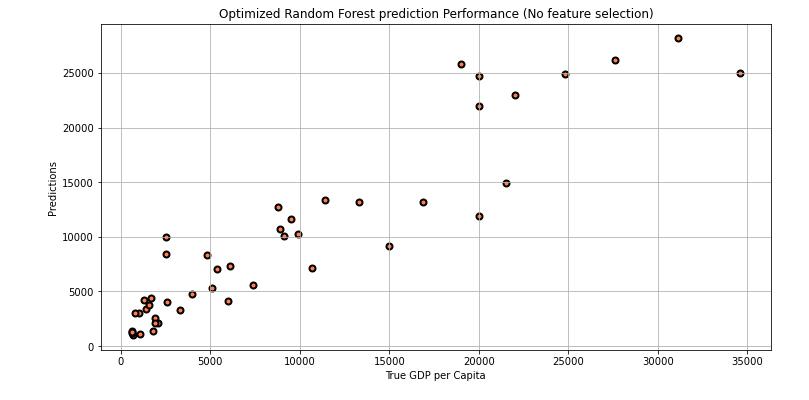
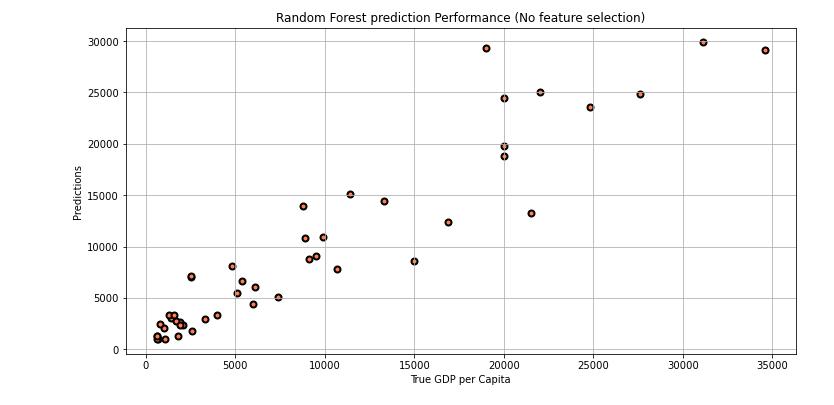
Table 3: RandomForestOptimizedAccuracy Performance
DataSplitting Criteria
MAE RMSE R2 SCORE
Optimized Performance 2360.747 3219.924 0.878
HerealsowehaveplottedtrueGDPpercapitaagainstthe prediction. And it is clear that Gradient Boosting gave us nearlysameperformanceasthatofrandomforest.
Fig 7:GradientBoostingPredictionPerformance
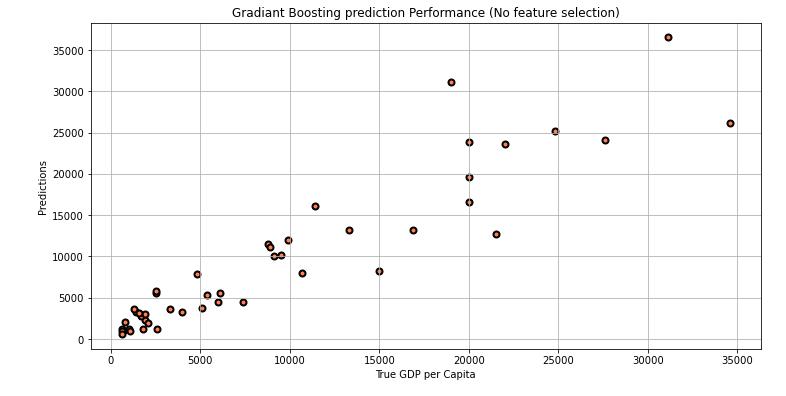
Table 4: GradientBoostingAccuracyPerformance
DataSplitting Criteria
MAE RMSE R2 SCORE
Allfeatures,No scaling 2280.462 3413.635 0.858
Selected Features,No scaling 2467.208 3789.297 0.826
DataSplitting
5. CONCLUSIONS AND FUTURE WORK
Weexploredallthesupervisedregressionmodelsinorderto getthebestfittingmodels.Wehavetrainedthemodelusing Linear Regression, Random Forest and Gradient Boosting machine learning algorithms and also estimated the performanceofthesemodels.EvaluationisdoneusingMAE andRMSEtechniquesandthencomparedallthreemodelsto getaclearoverviewofperformance.Theaccuracyobtained bylinearregressionalgorithmis82%andbyrandomforest is87%.Onthebasisoftheoptimizationprocess,themachine learningalgorithm“GradientBoosting”utilizedduringthis project worked well with the accuracy 89% in order to predictthetrueGDPpercapita.Finallydeployedthehighest accuracymodelto“GDPEstimationTool”whichestimates andforecastsGDPofacountryjustbygivingsomeattribute asinputforthatcountry.
REFERENCES
[1] Gary L Shelley and Frederick H Wallace. Inflation, money, and real gdp in mexico: a causality analysis. AppliedEconomicsLetters,11(4):223 225,2004.
[2] GangLong.Gdppredictionbysupportvectormachine trained with genetic algorithm. In 2010 2nd InternationalConferenceonSignalProcessingSystems, volume3,pagesV3 1.IEEE,2010.
[3] J.Roush,K.SiopesandG.Hu,”Predictinggrossdomestic productusingautoregressivemodels,”2017IEEE15th International Conference on Software Engineering

Research,ManagementandApplications(SERA),2017, pp.317 322.
[4] Martin Schneider, Martin Spitzer, et al. Forecasting austrian gdp using the generalized dynamic factor model.Technicalreport,2004.
[5] Vaishnavi Padmawar, Pradnya Pawar, and Akshit Karande. Gross domestic product prediction using machinelearning.

